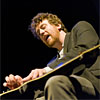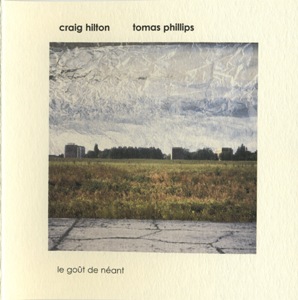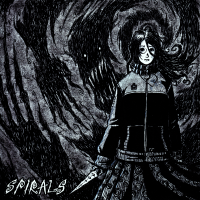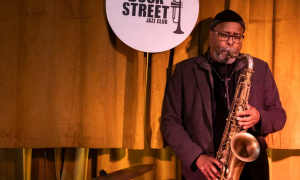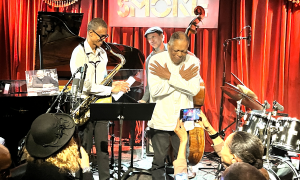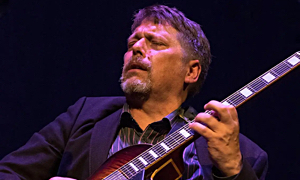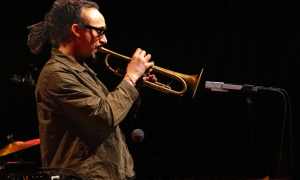Home » Jazz Articles » Live Review » Punkt 2011: Kristiansand, Norway, September 1-3, 2011
Punkt 2011: Kristiansand, Norway, September 1-3, 2011
September 3 Live Remix: J. Peter Schwalm/Nordic Live Electronics Network
As Punkt has evolved, it's become far more than a multidisciplinary art festival and a constellation of artists, journalists, photographers and fans. It's now a place where aspiring musicians can take part in seminars like those held this year at the University of Agder, including lectures by Evan Parker, Philip Jeck, John Tilbury, Anna Maria Friman and Samadhisound visual artist Chris Biggs, as well as an intimate technical seminar from John Paul Jones and Helge Sten. Punkt Elope has provided a venue for emerging groups from the Krisitansand area to get an opportunity for exposure to a larger audience.
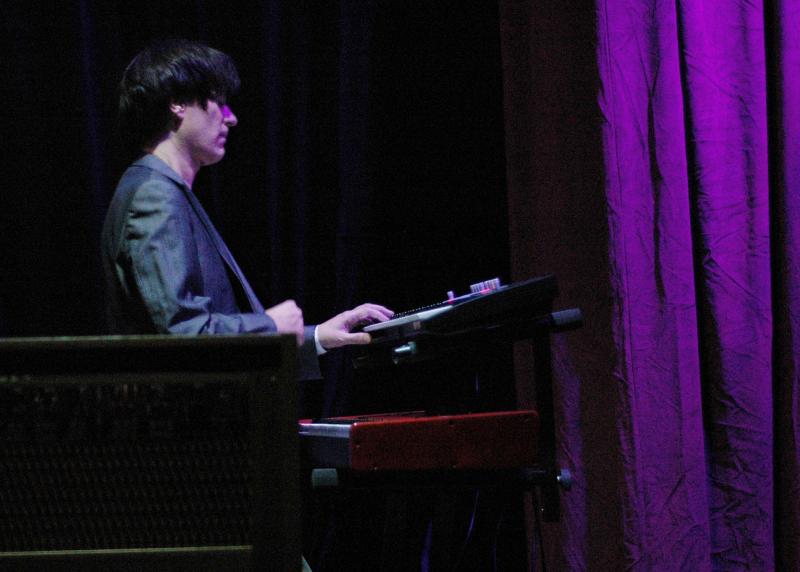 Guy Sigsworth
Guy SigsworthIn the past couple years, it's also tied into education, with artists like percussionist Adam Rudolph working with students from the university, culminating in his Go Organic Orchestra show that opened Agder Theatre festivities at Punkt 2009. In both 2010 and this year, live sampler/multi-instrumentalist Dino J.A. Deane}, who has collaborated with artists including Jon Hassell, John Zorn and Lawrence Butch Morris, worked with university students and also led live performances that were, sadly, missed due to travel difficulties. But for the first time this year, Punkt also hooked up students from Nordic Live Electronics Network, to work with J. Peter Schwalm, culminating in a live remix at the festival.
Nordic Live Electronics Network is a new initiative that, as the Punkt website describes, ..."gives talented music students and their teachers from the Nordic countries a unique chance to meet and (for the students) do a workshop and a live remix with a Punkt musician." In this case, Schwalm collaborated with half a dozen musicians, including a guitarist, singer, drummer and keyboardist, along with two laptop students. With plenty of source material coming from the main theatre performance, Schwalm and his students put things back on track in the Alfa Room, as elements of percussion and melody fragments from Jørgensen's voice and trumpet were used as a jumping-off point to shape a new musical context.
That the impact of Punkt is being felt on younger generations is one of the great successes of the festival, as Maria Norseth Garli was clearly channeling Sidsel Endresen, even as her own voice is clearly emerging; Guitarist Finn Loxbo, while sounding like neither, was clearly informed by the outside-the-box thinking of Eivind Aarset and Stian Westerhus, while drummer Christian Skjødt's textural approach and use of unusual ideas—like using a slinky toy to eke unexpected sounds from his kit—comes, in no small part, from innovations of percussionists like Ingar Zach and Thomas Strønen. Julie Falkevik Tungevåg played the celesta that Arve Henriksen used in David Sylvian's Plight and Premonition performance the previous evening, and in her careful choices, may have been largely hidden from the audience and her group, but was still clearly engaged.
It was more difficult to delineate the roles of Schwalm and the other two laptop musicians, but Vibeke Falden's smile at a couple points during the remix might have indicated something she had just done, but could also have been registering her own pleasure at what was going on around her, including the contributions of fellow laptop artist Mads With Kristofferson. Regardless, the remix was not just successful on musical terms, in and of itself, but in its clear acknowledgement of the festival's greater responsibility, to not just put on the best possible series it can, but to ensure that its distinctive aesthetic and philosophy continues to breathe and grow through the process of mentoring younger, up-and-coming artists.
September 3 Live Remix: Guy Sigsworth/Nils Petter Molvær
Having missed the main theatre double-bill of singer Susanne Sundfør and Sacred Harp, it might have been difficult to assess the success of its remix, from Guy Sigsworth and Nils Petter Molvær; but because it turned out, like Dans les Arbres the evening before, to be a standalone performance that didn't use anything from Sundfør or Sacred Harp—at best, inspired by the music—it turned out to be no problem whatsoever.
In contrast to Dans les Arbres, however, Sigsworth's set was anything but freely improvised. Instead, it was clear from the pages of sheet music on the celesta, that Sigsworth was reading for most of the 25-minute performance—that this was to be heavily structured, with the improvisational component coming largely from Molvær, who didn't have a whole lot of room to move in the early part of the show, but paradoxically was able to engage more directly as Sigsworth's piece gradually assumed its more detailed shape.
The chiming sound of the celesta working in loving consonance with Molvær, whose tone ranged from a clear, pure acoustic timbre to a more processed variant that included variable pitch shifting, allowed him to create moving harmony lines of varying intervals on the fly. Technology aside, however, it was the trumpeter's constant search for melodic elements that gave the set, regardless of context, a vivid, thematic focus. A continuous, episodic piece, the music moved comfortably between gentler passages, with Sigsworth returning to the celesta that dominated its opening minutes, to more fiery passages, where Sigsworth turned to two electric keyboards, broadening the electronic landscapes and programmed beats.
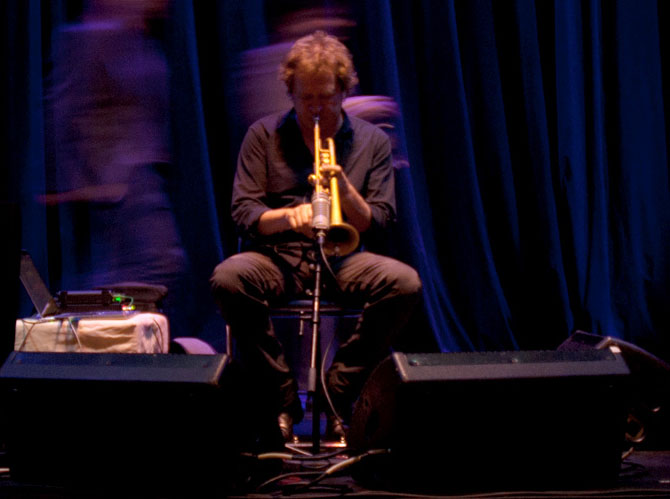
Nils Petter Molvær
Sigsworth was clearly having a blast, head bobbing up and down and hands punching the air as he literally leapt from celesta to piano. Like the songwriter/keyboardist, as the piece took off with booty-shaking grooves Molvær expanded his own sonic landscape, singing into the bell of his horn and manipulating it electronically. It may not have been a remix, but it absolutely was the most outgoing, rocking-est performance of Punkt 2011, and for Sigsworth—a Punkt guest for the past couple years and a participant in J. Peter Schwalm's remix of Jan Bang's ...and Poppies from Kandahar (Samadhisound, 2010) performance when Punkt visited Tallinn earlier this year—it was a fitting affirmation of why he's been so in-demand as a writer as well as producer, for artists ranging from Talvin Singh and Björk to Alanis Morisette and Madonna.
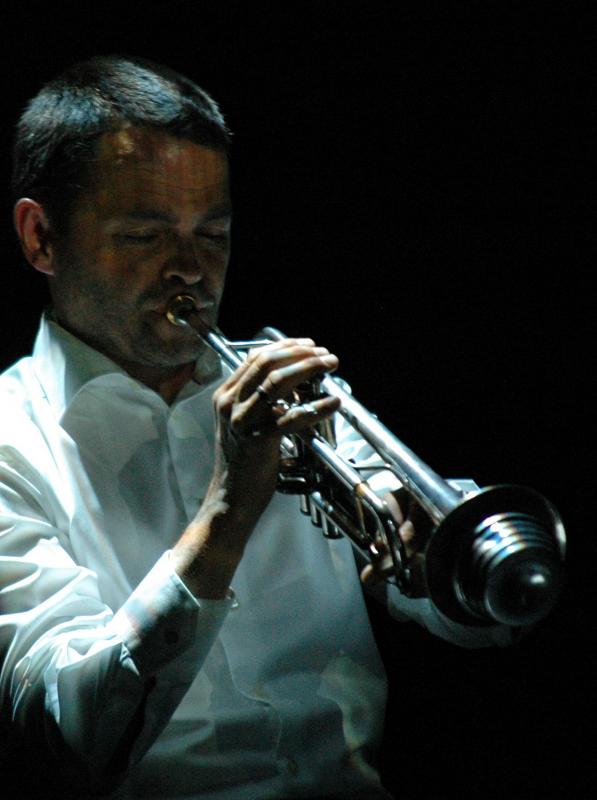 September 3 Concert: Arve Henriksen, Cartography, Special Edition
September 3 Concert: Arve Henriksen, Cartography, Special EditionSince releasing Cartography in late 2008, trumpeter Arve Henriksen has performed the music in a variety of combinations, always including Jan Bang, often featuring Eivind Aarset and, on occasion, recruiting the skills of percussionist Helge Norbakken to flesh the group out to a quartet, as he did at the 2009 Molde Jazz Festival. But while Henriksen has used music from an album heavily reliant on sound-sculpting, post-production wizardry and an almost reverse approach to writing as the grist for improv-heavy performance, he's never had the luxury of recreating it live in its more sonic glory, with its impressive cast of 13 largely Norwegian participants.
While unable to recruit everyone from the recording, for Cartography, Special Edition, Henriksen was able to put together a group that—with Bang, Aarset, Honoré. Friman and Ingar Zach—had more than enough musical firepower to accurately reproduce the album's lush, cinematic tableaus. But it was the presence of David Sylvian at Punkt that made real the possibility of truly recreating Cartography, as his spoken word on two of the album's twelve tracks gave the album book-ended narratives that were crucial to the music that surrounded them. And so, for the second-last Main Stage performance at Punkt 2011, Henriksen delivered a live version of Cartography that remained faithful to its improvisational core, but also remained true, for the most part, to the album's overall structure and narrative arc.
In a set lasting roughly 50 minutes, it was impossible to perform the album in its entirety, so Henriksen astutely chose the important touchstones of the album, its key melodies and, at times, near-symphonic movements making this one-time performance both reverent and distinct and separate. Bang's treatments of Sylvian's readings on the oblique "Before and Afterlife" and "Thermal" were as astute as ever, layering Sylvian's words in stuttering counterpoint, while Friman's evocative soprano was used more extensively than on the record, and provided a strong foil for Henriksen's shakuhachi-like tone on trumpet, and his own choirboy-pure falsetto. Freedom was a given for all, but for Zach, perhaps, more than the rest, given that the album featured so little percussion. With his array of implements large and small, he acted, at times, as an orchestrator, at other times a soft pulse. In smaller contexts, Aarset's contributions are more obvious, but for those who've had the luxury of numerous live encounters it was easy to discern the guitarist's distinctly un-guitar-like sound washes and serpentine melodies.
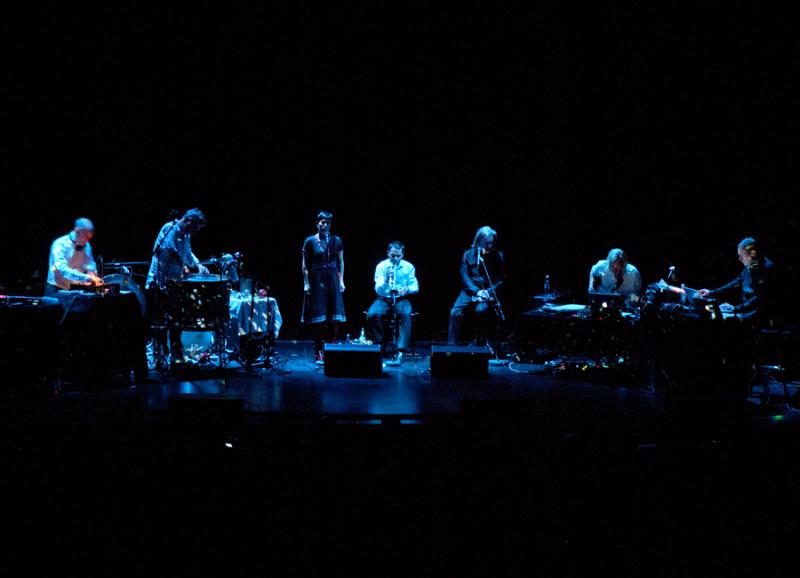
Cartography, Special Edition, from left: Jan Bang, Ingar Zach, Anna Maria Friman
Arve Henriksen, David Sylvian, Eivind Aarset, Erik Honoré
A gracious leader in every context, here Henriksen appeared particularly grateful for the group around him. Swaying with eyes closed during the spiritual ending, "Sorrow and Its Opposite," a faint smile gracing his face, it was impossible not to be moved by a one-time performance that, more than any of his smaller-group performances, captured the sheer emotive power and resonant essence of Cartography, while elevating it to a new level of in-the-moment interaction.
September 3 Concert: John Paul Jones/Helge Sten, Minibus Pimps
Sometimes a performance is so perfect, so complete, that hearing a remix would tarnish its memory. And so, after a much-needed break, it was time to return to the main stage for the final performance of Punkt 2011, the debut of a new electronic improvising duo featuring one classic rock legend, and one man whose sonic manipulations have become a cornerstone of the Norwegian improvising scene. Those who only think of John Paul Jones as Led Zeppelin's bassist/keyboardist will be surprised at an experimental nature that has become even more left-of-center in recent times, culminating in his 2010 Punkt appearance as an impromptu opener for Supersilent, but then even more surprising when he sat in with the Norwegian noise improvisers.
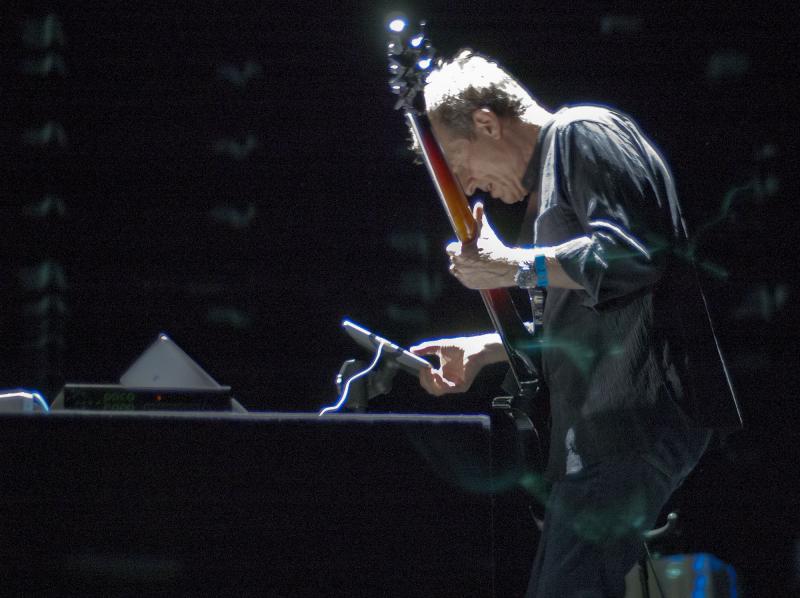 John Paul Jones
John Paul JonesIt was a given, then, that he'd return to Punkt the following year, though in exactly what shape was anybody's guess. It turns out, after the Supersilent set, that Jones had much in common with guitarist and overall electronic manipulator Helge Sten, especially an interest in the emerging musical possibilities of iPads. And so, Minibus Pimps was born, an improvising collaboration that used iPads as a starting point, but expanded to Jones playing largely unrecognizable bass guitar and violin, fed through the ubiquitous MacBook (if Punkt isn't an official Apple endorser, it ought to be), while Sten turned to electric guitar that, like Jones and his instruments, seemed more like a trigger than an overt musical instrument.
The set began in total darkness, as the curtain rose on a spare stage, with two tables facing each other in the center, with Sten's guitar and various devices on the left, and Jones' gear on the right. High-pitched electronic sounds began to fill the room, as Sten and Jones slowly entered from opposite sides of the stage, iPads in hand, gradually building the sound in breadth and volume as they made their way to their individual stations. What was, perhaps, intended as a bit of theatrical drama, unfortunately fell a little flat when it became clear that there was little more to come in the 45-minute set. Jones alternated between bass and violin, and while it's true that the heavily processed sonics coming from one were in a much lower register than the other, that was effectively the extent of it. Sten, too—despite far greater depth in the context of Supersilent—seemed to be mining a very specific sonic space, both with his guitar and the rest of his gear, but none of it succeeded in giving the set real shape. It's one thing to be improvising with noise, but without some kind of development, it ultimately loses its purpose and becomes hypnotic at best.
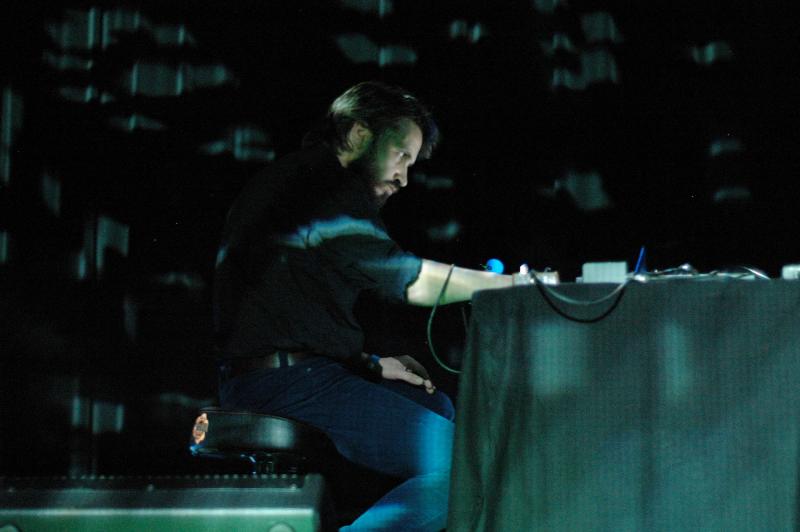 Helge Sten
Helge StenIf it weren't for Tord Knudsen's as-ever intriguing and spontaneous visuals, the set would likely have failed, but with a series of small boxes around the stage, on which he projected various patterns and moving images, the performance did become something worth experiencing, even if the actual music was less than engaging. Building to an inevitable peak, the set then began to slowly diminish, as Jones and Sten once again picked up their iPads and began moving off the stage. It might not have been such a disappointment, were this not the final show of Punkt 2011, but when past years' closers have been so perfectly climactic, it only made Minibus Pimps even more of a let-down; in retrospect, Henriksen's show would have been a far better way to end events on the Main Stage.
September 3 Live Remix: Molvær/Mazur/Aarset/Bang/Honoré
Still, with one more show left at Punkt, the festival still had the chance to end on a high note, and in its final remix, it did just that. Sometimes a remix doesn't succeed, but more often than not, in those cases, the journey is still worthwhile, even if it doesn't reach its intended destination. Still, there have also been times in Punkt's seven-year history when the remix actually surpasses the source performance. There wasn't a whole lot of variation for Jan Bang and Erik Honoré to grab from the Minibus Pimps show, but in a group that also featured Eivind Aarset, Nils Petter Molvær and Marilyn Mazur, they had more than enough real-time music to make this, along with the Bang/Honoré/Endresen remix of the Dai Fujikura opener on Friday, one of Punkt 2011's most successful remixes—and, in fact., most successful shows, period.
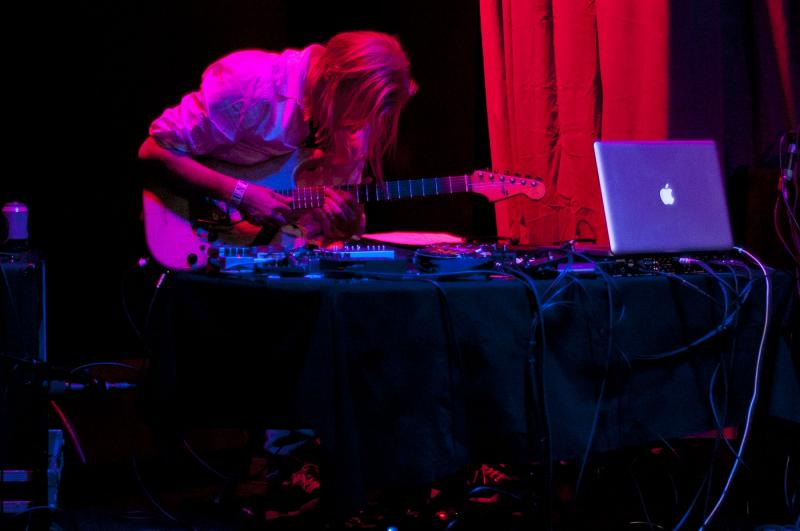 Eivind Aarset
Eivind AarsetReduced to a much smaller percussion setup, one thing became quickly clear as she spent most of her time behind a conventional kit—Mazur is one heckuva drummer, capable of delicate pulses and thundering grooves, ears open to everything going on around her, as she responded with nanosecond-precision to Molvær's liquid lines, Aarset's expansive sonic landscapes, and to Bang, who was also taking in everything around him but turning it around, and feeding it back to the rest of the group with split-second intuition. His role was less clearly defined or delineated, but the communication that Honoré shared with Bang, in a musical partnership dating back more than 20 years, is something to behold, even if it's often so subtle as to be barely perceptible to the naked eye.
From the persistent noise of Minibus Pimps to a remix that moved into powerful grooves and numerous climaxes that ebbed, only to flow back to dramatic (but never melodramatic) peaks, Aarset was the head, Molvær the heart, and Mazur the soul of a beautiful end to Punkt 2011, and the festival's last-ever show to take place in the soon-to-be-demolished Agder Theatre.
Wrap-Up
And so, with the festival over and the Agder Theatre soon to be a memory, Punkt is in transition. 2011 featured a number of highs, and some first-time/once-ever performances that continue to make it a festival that simply cannot be missed. There were some weak points also, but when your objective is to relentlessly think outside the box and push all perceive envelopes, it's impossible not to experience a few missteps. But if one of the most exciting aspects of improvisation is its risk, then sometimes that has to be enough, even if the end result is less than successful
As Bang and Honoré, with the rest of the Punkt team, prepare to move the festival to the larger, more modern and more high-tech Kilden Performing Arts Centre, they face the challenge of working in a larger context that will make possible many things the Agder never could, while retaining the intimacy that has made Punkt less a spectator sport and more a shared experience for everyone involved.
2012 will be a seminal year for Punkt, one that determines the shape of its future; but for those who've made Kristiansand and other Punkt destinations an essential part of their annual plans, there's little doubt that the festival will continue its year-after-year success as something that began as a festival but has become much more: a constellation of people from across the globe who share a similar passion, people who both feed and share that passion through growing interactions that have increased the festival's purview each and every year—from Punkt's humble Norwegian beginnings to an international collective that collects people from countries including Canada, the United States, England, Germany, France, Japan, Estonia, Italy, Switzerland, Ireland, Finland, Algeria, Portugal, Sweden and The Netherlands. One country at a time, and one remix at a time, Punkt continues to build its reputation an artistically uncompromising festival where everything is permitted and anything is possible.
Visit David Sylvian, Samadhisound, Dai Fujikura, Jan Bang, Sidsel Endresen, Erik Honoré, Evan Parker, Okkyung Lee, Dans les Arbres, Koboku Senjû, Marilyn Mazur, J. Peter Schwalm, Guy Sigsworth, Nils Petter Molvær, Minibus Pimps, Eivind Aarset and Punkt Festival on the web.
Photo Credits
Page 2, Works by Dai Fuijikara: Alf S. Solbakken
Page 4, Koboku Senjû: Alf S. Solbakken
Page 5, Marilyn Mazur/Trio: Alf S. Solbakken
Page 6: Nils Petter Molvær: Alf S. Solbakken
Page 7: Cartography, Special Edition: Alf S. Solbakken
All Other Photos: John Kelman
Tags
PREVIOUS / NEXT
Support All About Jazz
 All About Jazz has been a pillar of jazz since 1995, championing it as an art form and, more importantly, supporting the musicians who make it. Our enduring commitment has made "AAJ" one of the most culturally important websites of its kind, read by hundreds of thousands of fans, musicians and industry figures every month.
All About Jazz has been a pillar of jazz since 1995, championing it as an art form and, more importantly, supporting the musicians who make it. Our enduring commitment has made "AAJ" one of the most culturally important websites of its kind, read by hundreds of thousands of fans, musicians and industry figures every month.


